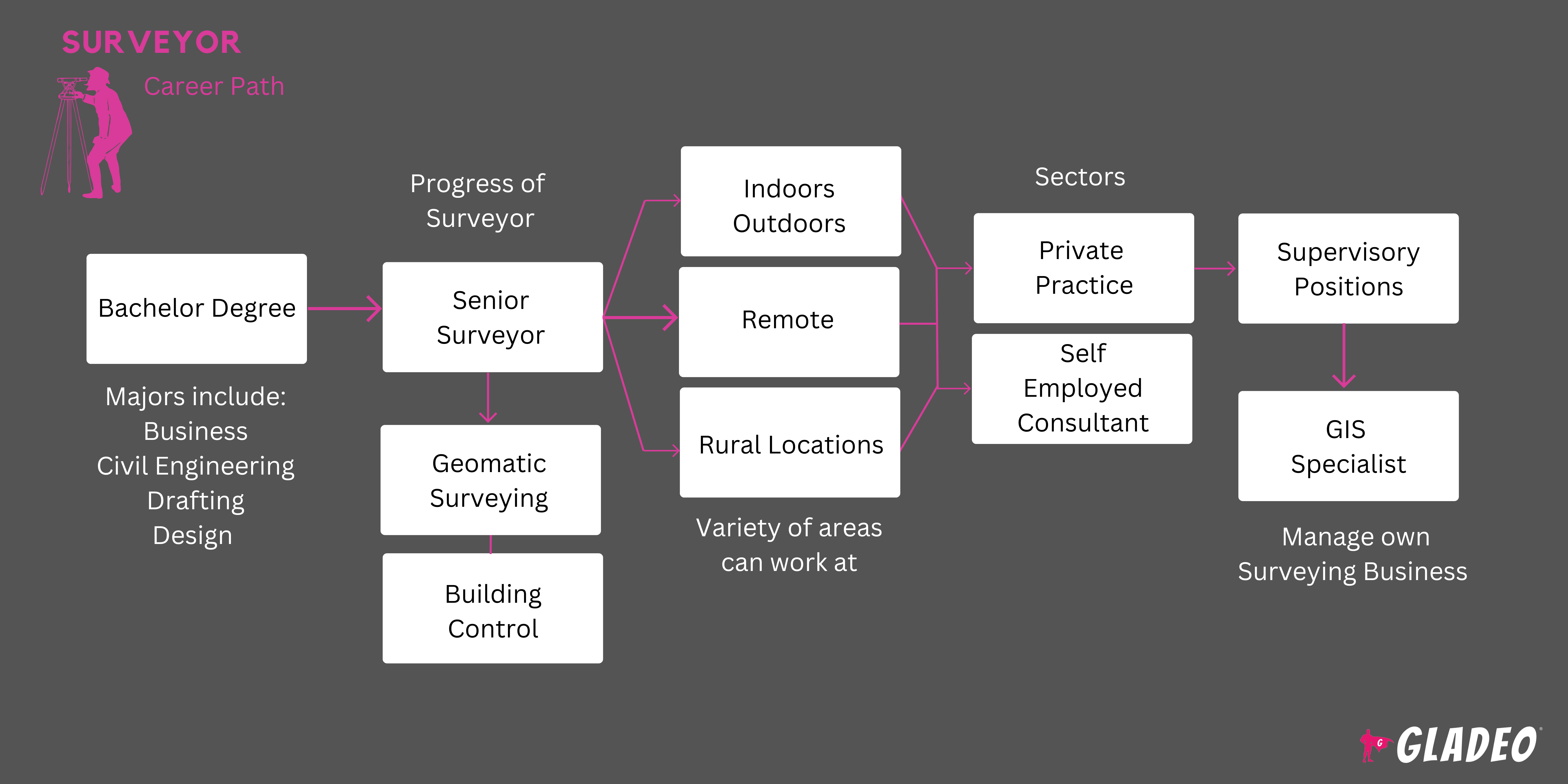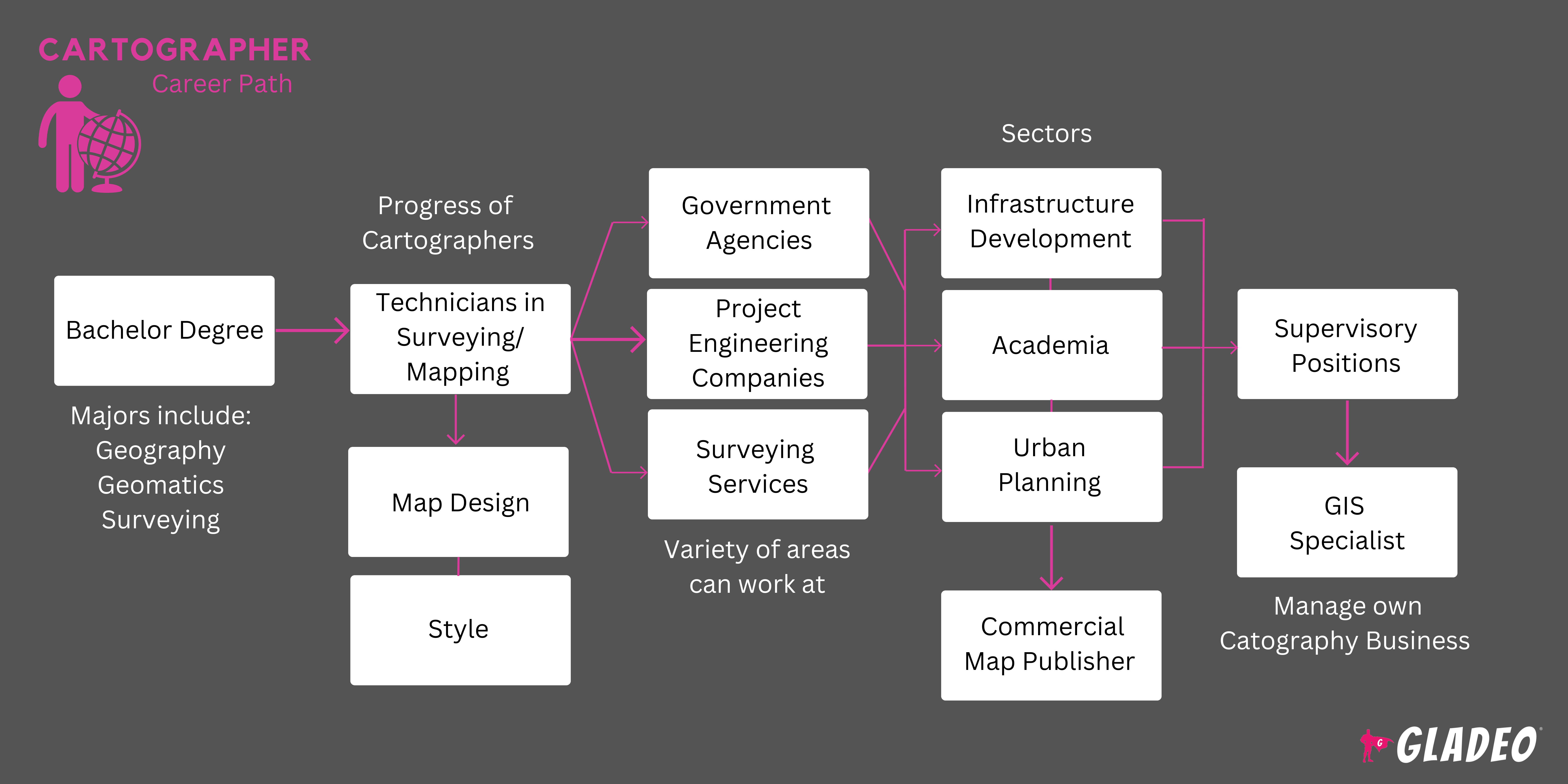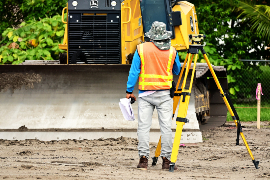聚光灯
地理信息工程师、地理空间分析师、土地测量员、地理信息系统 (GIS) 专家、地形测量员、地籍测量员、遥感专家、制图技术员、制图设计师、地理空间数据分析员
测量师和制图师的角色并不完全相同,但他们的工作非常密切,因此我们决定将这两个领域捆绑在一起,形成一个简介由于 环境科学指出,两者都是 "收集数据和绘制我们周围的景观",他们的工作是 "用于建筑、绘图和地质研究"。
测量员实际访问他们需要绘图的实际地点。他们使用测量工具和技术来收集数据,然后将其插入软件。制图师利用采集到的信息绘制各种用途的地图,如显示边界或海拔和水源等地理特征。测量员和制图员都需要不断努力,以确保地图保持准确和最新。测量员暴露在天气条件和潜在的户外危险中,而制图员更多的时间是在室内使用程序,但可能需要出差。
- 帮助捕获和利用地理空间数据,用于制图和规划目的
- 为成千上万的组织提供改善运营的工具,使其有能力。
- 通过测绘和寻找自然灾害点,有可能拯救生命
工作日程
- 测量员和制图员通常全职工作。在某些情况下,如果任务很紧急,可能需要加班。有些人可能只在需要的情况下从事兼职工作。
典型职责
测量师
- 研究和审查现有的地图、调查、契约、土地所有权、租赁合同和其他与法定地理边界有关的文件。
- 访问要进行实地调查的各个地点
- 注意到重要的地标和其他固定的参考点和特征
- 使用设备来计算各种表面的准确距离和角度测量
- 根据需要,指导其他调查小组成员
- 绘制草图和地点草图,显示相关的地形特征和地产线
- 确定地形的高度、深度、形状、尺寸和其他确定地产线所需的方面
- Record latitudes and longitudes of boundaries using GPS and other tools such as theodolites, transits, and levels
- 记录调查数据并用于编写报告、图表、地图和其他文件
- 为客户、机构或在某些情况下为法律专业人士制作带有视觉效果的书面调查结论
- 根据需要,与工程师和建筑师合作
- 校准和修改测量仪器
- 进行大地测量以帮助评估地貌和地形方面的问题
- 在财产纠纷案件中提供宣誓证言
- 规划出航空测量项目,包括使用哪些设备
- 对湖泊和河流等水体进行调查
- 掌握测量/绘图技术的最新发展情况
- 使用摄影测量地图和电子数据处理工具
制图师
- 确定收集地理数据的有效来源;建立数据使用的标准规范
- 从调查、报告、航空照片、卫星图像、远程传感器和现有地图或图表中收集地理数据
- 过滤数据以确保只使用最新、最相关和最准确的信息
- 检查列出或显示当前财产边界的法律文件
- 创建综合数据库
- 根据雇主的需要,决定合适的地图内容、布局、尺寸、颜色和其他因素。
- 使用合适的数据和程序来进行视觉表达,如数字和图形地图、图表、三维模型、表格等。
- Reference important geographic features and details, including control points, hydrography, geodetic points, elevations, planimetric features, and topographic features
- 审查最终产出是否准确
- Use precision stereoplotting tools and drafting instruments to note details on photos
- 根据需要进行现场访问,观察并核实信息的准确性
额外责任
- 利用当前数据定期更新地图
- 根据需要,培训和监督其他团队成员
- 了解行业变化和技术进步的最新情况
- 参加专业组织的活动,分享信息并向他人学习
软技能
技术技能
- 计算机辅助设计(CAD)程序
- 数据分析软件
- 数据库管理系统
- 设计软件、蓝图、3D模型、技术计划
- 开发环境软件
- 企业资源规划
- Geographic information system, such as ESRI ArcGIS
- Geospatial industry programming languages, including Python, JavaScript, C+, HTML/CSS, Swift, Java, C#, SQL, PHP, Rust, Lotlin, Ruby, TypeScript, Matlad, Go, etc.
- Google Earth, KMZ files, and lidar
- 图形/照片成像程序
- Map creation software like CDA International’s Manifold System or ITT Visual Information Solutions
- 移动定位服务软件
- 曾从事/熟悉咨询工程师和/或测量师的工作
- Scientific software, such as Coordinate geometry COGO
- 对地理的理解
- 建筑和工程服务
- 建筑
- 政府机构
- 管理、科学和技术咨询服务
- 采矿、采石以及石油和天然气开采
测量员和制图员的工作对许多行业至关重要,准确的结果往往是关键。精确性是游戏的名称,而错误可能是昂贵的。重大的土地纠纷可以通过准确的测量来解决,而不准确的结果可能导致昂贵的法律诉讼。
In addition, many companies make business decisions based on maps and other information supplied by Surveyors and Cartographers. Expectations run high and related sacrifices include reputational damage for the workers or even financial liability in some cases. This is why Surveyors may need business insurance. Another sacrifice is the need for frequent travel and outdoor work, sometimes during inclement weather conditions.
Surveyors and Cartographers must keep up with the significant changes that are revolutionizing their lines of work. Remote-control unmanned aerial vehicles (UAVs) and drones aren’t new to the world of surveying, but they are increasingly relied upon for their flexibility, ease of use, and ability to obtain data that would otherwise be much harder (if not impossible) to acquire!
But another disruptive technology — the cloud — has expanded capabilities in terms of gathering and managing large datasets, especially with the advent of the 5G mobile network. Speaking of mobile, mobile mapping systems are being used to scan all sorts of environments very quickly, cutting down survey times and leading to notable cost savings over the long term.
勘测员和制图员可能很喜欢在户外活动,关注周围环境的细节。他们可能喜欢查阅地图进行导航或了解世界各个地区的信息。勘测员可能是更喜欢 "动手 "的类型,他们喜欢卷起袖子与小工具一起工作。制图师可能花更多的时间与计算机和数据打交道。两者都可能有点痴迷于他们所做的任何事情的准确性
测量师
- 测量员和制图员通常需要至少有一个学士学位,最好是来自ABET认证的大学。 认可的课程
- 测量师的专业是数量或土地测量、水文测量、工程(通常是土木或机械),或者在某些情况下是自然资源。
- 之后,他们必须在工作约4年后获得州执照,并通过 全国工程和测量师考试委员会的测量学基础知识和测量学原理与实践考试
- 测量员必须学会如何使用 设备如经纬仪、卷尺、全站仪、三维扫描仪、GPS/GNSS、水平仪和棒子等等。
- 他们还将学习常见的测量软件,如Civil 3D、AutoCAD、BIM 360、Revit、Navisworks等。
制图师
- 制图师主修制图学、测量学、地理学或地理信息学,有大量的编程、移动制图、地理信息系统(GIS)和相关主题的课程。
- 一些州要求制图师获得测量师执照
- 学生需要学习如何使用各种软件程序,如 ArcGIS和 地图信息专业
- 其他学习的主题包括 波音SoftPlotter, AutoCAD。 激光雷达传感器,以及制图方法、理论和原则。
- 测量师有几个国家认证,包括。
- 美国职业地雷师协会 -
- 注册专业地税师
- 注册地师
- 注册专业地税师
- 美国摄影测量和遥感协会 -
- 认证摄影测量技术员
- 认证的GIS/LIS技术专家
- 坐标计量学会- 注册便携式三维计量师1级
- 地理信息系统认证机构- 地理信息系统专业人员
- 绿色商业认证公司- LEED AP 邻里关系发展
- 全国专业测量师协会 -
- 注册测量师技术员
- 注册联邦测量师
- 美国职业地雷师协会 -
- 制图员的证书包括。
- 美国摄影测量和遥感协会 -
- 遥感认证测绘科学家(ASPRS)。
- 认证测绘科学家,GIS/LIS(ASPRS)。
- 国际评估员协会- 地籍测绘专家
- 国家地理空间情报局(National Geospatial-Intelligence Agency)。 -
- GEOINT专业认证制图学
- GEOINT专业认证图像学
- 美国摄影测量和遥感协会 -
- 注意,美国地理空间情报基金会 美国地理空间情报基金会"从2021年2月1日起,暂时自愿中止认证GEOINT专业人士(CGP)计划,为期三(3)年"。请查看他们的网站,了解更多信息和其他机会
- 考虑学费、折扣和当地奖学金的机会(除联邦援助外)。
- 在决定是否报名参加校内、网上或混合课程时,要考虑你的时间安排和灵活性。
- 查看该项目教师的奖项和成就,看看他们都做了哪些工作
- 仔细观察他们的教学设施以及他们让学生训练的设备和软件。
- 查看就业安置统计资料和该项目校友网络的详细信息
- 志愿参加学校活动,你可以学习如何有效地作为一个团队工作,练习你的软技能,并管理项目
- 报名参加高中课程,如算术、代数、几何、三角学、计算机科学、计算机编程、地理、机械制图和绘图。
- 考虑申请土地测量或制图学徒。
- 未来的测量师可能希望通过兼职建筑工作获得工作经验。这种实践可能有助于发展一些测量设备的技能,并培养身体的耐力。
- 写下和你一起工作的人的名字和联系方式,因为他们有一天可能会成为未来的工作推荐人。
- 根据你的目标,学习与测量学或地图学有关的书籍、文章和视频教程
- 询问一些经验丰富的测量师或制图师,你是否可以跟随他们,了解他们的日常活动。
- 加入专业组织,了解趋势并扩大你的网络
- 如果你符合资格要求,获得一个专业领域的认证,以加强你的证书。
- 想想你想在哪个州工作,所以你可以审查他们的执照要求
- 考虑你想专注于哪个行业,并编制一份潜在雇主的名单。查看他们的网站,了解他们的需求,并查看他们的职业网页。
- 不要等待开始起草你的简历。把你学会使用的软件和设备记录下来,这样你就不会迷失方向。
- 通过查看Indeed和其他招聘门户网站上的招聘信息,提前审查工作标准。


- 测量或制图相关的学徒可能是一个很好的突破方式
- 在申请前尽可能多地学习如何使用相关工具、设备或程序
- Upload your resume on job portals such as Indeed, Simply Hired, Glassdoor, and Zippia and keep it current
- Note, some national and state professional associations that list jobs, too, such as the National Society of Professional Surveyors’s job board, GIS Jobs Map, or the Professional Land Surveyors of Oregon job board
- 搜索招聘广告并仔细筛选,以确保你符合申请条件
- 与在职的测量师或制图师联系,询问求职技巧
- 通过你的网络传播你已经开始找工作的消息
- Move to where the most job opportunities are! The states with the highest employment levels for Surveyors are Texas, California, Florida, Colorado, and Georgia. For Cartographers, it’s Texas, Colorado, California, North Carolina, and Virginia
- 向你的大学课程或就业中心寻求帮助,如简历写作、模拟面试、招聘会日程等。
- 许多项目作为招聘人员的管道,所以要让他们知道你已经准备好工作了!
- Review Surveyor and Cartographer resume templates to get ideas for wording and formats
- 在你的简历上列出所有的教育、技能、培训和工作经历
- 考虑让专业的简历作家或编辑来起草或至少审查你的简历
- 提前询问以前的老师和主管,他们是否可以作为个人推荐人。不要在未经允许的情况下列出他们的联系信息,让他们措手不及。
- Study Surveyor and Cartographer interview questions to see what you might be asked
- Make an account on Quora to ask job advice questions from workers in the field
- 要想面试成功,着装一定要得体!
- 在你的实习工作经验阶段,密切关注并学习所有你能做的。尽管你已经离开了学校,但在最初的几年里,你仍然处于 "学习模式"(也包括以后)。
- 不断进步!一旦你有资格申请并参加测量学基础知识和测量学原理与实践考试,就可以获得执照。
- 通过在线课程、硕士学位或高级认证,不断提高你的技能和学习新事物,使你有资格获得更高层次的权力,从而保持在游戏的顶端。
- 通过准确和负责任的态度建立信任。遵守最后期限并确保高质量的结果
- 观看并向更多资深测量师和制图师学习。提出问题并记下最佳做法
- 在社区和通过增加对专业组织的参与来扩大你的专业网络
- 在组织活动中做讲座,发表文章,并努力赢得州和国家的奖项,以提高你的专业声誉。
- The NSPS Surveying Excellence Award is just one example of possible recognition to strive for!
- 安排与你的主管或经理谈话,讨论晋升的机会
- If needed, consider applying to new jobs with more promotion potential — or launch your own land surveying company!
网站
书籍
- Cartography, by Kenneth Field
- GPS for Land Surveyors, by Jan Van Sickle
- Land Surveying Simplified, by Paul L. Gay
The technology behind surveying and cartography is always evolving, and sometimes it’s hard to keep up. Both jobs are challenging and rewarding, but may not be the best fit for some workers. For those who want to consider a few alternative paths, the Bureau of Labor Statistics lists related occupations to think about!
新闻联播

特色工作

在线课程和工具








